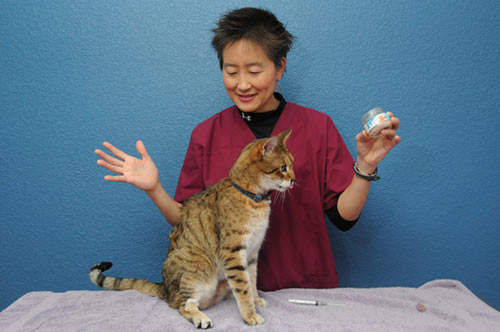Albuquerque Journal Article – Diabetic Cat Feels Bad
My excellent and, sadly, late colleague Dr. Sophia Yin presents a wonderful method for giving injections to cats. The pet parent with this diabetic kitty can learn to make it a good experience rather than a source of fear.
Complications like Urinary Infections Derail Good Control
Question:
I have a 14-year-old cat who was diagnosed with diabetes about 3 years ago. She was stable; her insulin (glargine) dose was 1 1/2 units. A month ago she became lethargic and indifferent to food. Her fructosamine test showed 400 and there was sugar in her urine. Her insulin was increased to 2 units. She’s had good and bad days since but hasn’t completely returned to her normal self. I’m no longer convinced that Prescription Diet m/d is the best food for her.
Dr. Nichol:
Something important is amiss with your kitty. It’s not unusual for diabetics to have other disorders crop up. Any unresolved complication can derail good control. To screen for problems all diabetics should have a chemistry profile, blood count, and urinalysis every 3-6 months. Urinary infections are common because high blood sugar leads to excessive sugar in the urine. Bacteria love sugar.
Once those smoldering issues have been resolved a 12 hour blood curve can be done to pinpoint the up and down fluctuations in your cat’s blood sugar. A drop of blood is glucose-tested every 2 hours and the values plotted on a graph so the dosing and timing of insulin and meals can be custom-fitted to your cat. You can learn to do this at home using a glucometer.
The fructosamine test is also important. It gives an approximate average of the blood sugar over the preceding 2-3 weeks. Based on these lab values, increasing your kitty’s glargine insulin dose may be the best move. In cases where glargine loses its effectiveness we switch to protamine zinc (Prozinc) insulin.
Food also matters. Prescription m/d is best for most feline diabetics because, like their natural diet, it’s high in protein and low in carbohydrates. As a fat cat’s weight diminishes many become more active and require less insulin. Continuing the same dose can lead to dangerously low blood glucose levels. As they approach a healthy weight of 9 – 11 pounds some actually become normal, no longer needing any treatment other than an appropriate diet. Your veterinarian gave you good, research-based advice. I urge you and your cat to follow doctor’s orders.
Each week Dr. Jeff Nichol makes a short video or podcast to help bring out the best in pets. Sign up at no charge at drjeffnichol.com. Dr. Nichol treats behavior disorders at the Veterinary Emergency & Specialty Centers in Albuquerque and Santa Fe (505-792-5131). You can post pet behavioral or physical questions at facebook.com/drjeffnichol or by US Post to 4000 Montgomery Blvd. NE, Albuq, NM 87109.


